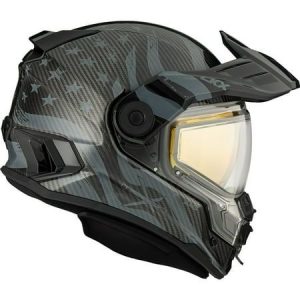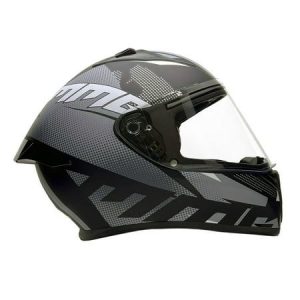Your Trusted Lid: When to Replace Your Motorcycle Helmet
Your motorcycle helmet is your essential safety gear. It’s the barrier between you and the pavement in the unfortunate event of an accident. But just like any piece of equipment, helmets don’t last forever. Knowing when to replace your motorcycle helmet is crucial for ensuring your safety on the road.
This comprehensive guide dives into the factors that influence helmet lifespan, the telltale signs it’s time for a new one, and the potential consequences of clinging to an outdated helmet.
Understanding Helmet Lifespan: Age, Use, and External Factors
Unlike food with an expiration date, motorcycle helmets don’t come with a definitive “replace by” timeframe. However, several factors contribute to a helmet’s lifespan:

-
Age: Manufacturers recommend replacing helmets every five years from the date of manufacture, regardless of use. This accounts for the natural breakdown of materials like the inner liner and adhesives that hold the helmet together.
-
Frequency of Use: A helmet used daily for commuting will wear out faster than one used occasionally for weekend rides. The more you use your helmet, the more frequent inspections and potential earlier replacement might be necessary.
-
Exposure to Elements: Sun exposure, extreme temperatures, and harsh chemicals can degrade the helmet’s shell and liner materials. Store your helmet in a cool, dry place away from direct sunlight to maximize its lifespan.
-
Accidents or Drops: Even a minor drop or bump can compromise the helmet’s structural integrity. If your helmet has been involved in an accident or a significant fall, it’s crucial to replace it, regardless of visible damage.
Warning Signs: When Your Motorcycle Helmet Needs an Upgrade
While a five-year lifespan is a general guideline, there are specific signs that indicate your helmet needs replacing sooner:

-
Visible Damage: Cracks, deep scratches, or gouges in the shell compromise the helmet’s ability to absorb impact. If you see any of these, it’s time for a new helmet.
-
Loose or Worn Liner: The inner liner is crucial for a snug fit and impact absorption. If the liner feels loose, excessively worn, or has lost its ability to return to its original shape after removal, replace the helmet.
-
Sticky or Brittle Materials: Over time, the helmet’s liner and padding can become sticky or brittle due to exposure to sweat, heat, and chemicals. This signifies a breakdown of materials and reduced effectiveness.
-
Difficulty Fastening Straps: If the chin strap has frayed, become difficult to fasten securely, or shows signs of wear, it’s time to replace the helmet. A secure strap is vital for keeping the helmet in place during an accident.
-
Reduced Visibility: A scratched or foggy visor significantly hinders your vision. While a scratched visor can sometimes be replaced, excessive wear or a cloudy, old visor necessitates a new helmet.
The Risks of Riding with an Outdated Motorcycle Helmet: Don’t Gamble with Safety
Replacing a motorcycle helmet might seem like an unnecessary expense, but the potential consequences of holding onto an outdated one far outweigh the cost:

-
Decreased Impact Protection: A compromised helmet shell or degraded liner significantly reduces the helmet’s ability to absorb impact during an accident, increasing the risk of head injuries.
-
Poor Fit: A loose or worn-out liner compromises the helmet’s snug fit, which is essential for optimal protection. In an accident, a loose helmet can shift or even come off entirely, leaving your head exposed.
-
Reduced Visibility: A scratched or foggy visor hinders your ability to see clearly, potentially leading to accidents caused by impaired vision.
-
Comfort Issues: A worn-out helmet can be uncomfortable to wear, leading to fatigue and reduced focus while riding.
Investing in a new helmet is an investment in your safety and peace of mind. Don’t wait for a serious accident to realize the importance of a properly functioning helmet.
Finding the Perfect Fit: Selecting Your New Motorcycle Helmet
Replacing your helmet is an opportunity to find the perfect fit and enhance your riding experience. Here are some tips for choosing the right helmet:

-
Research Different Types: There are various helmet styles available, from full-face to modular to off-road. Consider the type of riding you do most often and choose a helmet that offers the appropriate protection and features.
-
Try Before You Buy: A proper helmet fit is crucial. Visit a reputable motorcycle gear store and try on different helmets to ensure a snug, comfortable fit that doesn’t obstruct your vision or movement.
-
Safety Certifications: Look for helmets that meet safety standards set by organizations like the Snell Memorial Foundation or the Department of Transportation (DOT).
-
Comfort Matters: Choose a helmet with a comfortable liner and ventilation system. You’ll be wearing it for extended periods, so prioritize comfort along with safety.
- Consider Your Budget: Motorcycle helmets range in price depending on brand, features, and materials. Set a realistic budget and choose a helmet that offers the best value for your money.
Caring for Your Motorcycle Helmet: Extending Its Lifespan
By properly caring for your helmet, you can maximize its lifespan and get the most out of your investment:
-
Regular Cleaning: Clean the helmet’s exterior with a mild soap solution and lukewarm water. Remove the liner (if removable) and wash it according to the manufacturer’s instructions.
-
Store it Right: Always store your helmet in a cool, dry place away from direct sunlight and extreme temperatures. Avoid storing it near harsh chemicals or solvents.
-
Limit Sun Exposure: Prolonged sun exposure can degrade the helmet’s materials. Park your motorcycle in the shade whenever possible, and avoid leaving your helmet on the bike for extended periods.
-
Inspect Regularly: Before every ride, take a few minutes to inspect your helmet for any signs of damage, wear, or loose components. Address any issues promptly.
By following these simple care tips, you can extend the lifespan of your helmet and ensure it continues to provide optimal protection for years to come.
Extending Your Helmet’s Lifespan: Care and Maintenance Tips
While replacing your helmet every five years is crucial, proper care and maintenance can help extend its lifespan and performance:

-
Clean Your Helmet Regularly: Use a mild soap solution and lukewarm water to clean the helmet’s shell and visor. Remove the liner (if removable) and wash it according to the manufacturer’s instructions.
-
Store Your Helmet Properly: Always store your helmet in a cool, dry place away from direct sunlight and extreme temperatures. Avoid storing it near harsh chemicals or solvents.
-
Inspect Your Helmet Regularly: Before every ride, take a close look at your helmet for any signs of damage, wear, or loose components. Address any issues promptly.
-
Replace Worn-Out Parts: Visors, straps, and liners can be replaced individually as they wear out. This can extend the life of your helmet without needing a complete replacement.
By following these simple care tips, you can maximize the lifespan and effectiveness of your motorcycle helmet.


